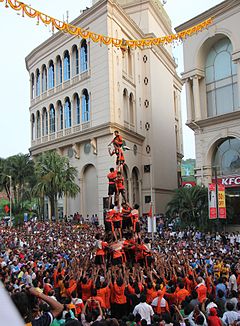
Back দহি হান্ডি Bengali/Bangla Govindes Catalan Dahi Handi Spanish दही-हांडी Hindi ഉറിയടി Malayalam दहीहंडी Marathi ଦହି ହାଣ୍ଡି OR ਦਹੀਂ ਹਾਂਡੀ Punjabi தஹி ஹண்டி Tamil
| Dahi Handi | |
|---|---|
 Govindas forming a human pyramid to reach the Dahi Handi (earthen pot) in Hiranandani Gardens | |
| Also called | Utlotsavam, Sikhyotsavam[1] |
| Observed by | Hindus |
| Type | Religious |
| Celebrations | 1 day |
| Observances | Fasting, praying, making a human pyramid and breaking an earthen pot filled with curd tied at a convenient/difficult height |
| Date | Shravan, Krishna Paksha, Navami |
| Related to | Lord Krishna |
Dahi Handi (also known as Gopal Kala or Utlotsavam) [3][4][5] is an entertainment and competitive event associated with Krishna Janmashtami, the Hindu festival celebrating the birth of Krishna.[6][7]
During the event, which takes place during August or September on the day after Krishna Janmashtami. It involves communities hanging a clay pot filled with yogurt (dahi), butter, or another milk-based food at a convenient or tall height. Young men and women form teams, make a human pyramid, and attempt to reach or break the pot. As they do so, people surround them, sing, play music, and cheer them on. It is a public spectacle, and an old tradition. More recently, Dahi Handi was lavished with media coverage, prize money and commercial sponsorships.[6][8][9] The event is based on the legend of the god Krishna along with his friends mischievously stealing butter and other curd from neighbouring homes in Gokul as a child. He is also called Makhan chor or butter thief. The neighbours would try to avert his mischief by hanging the pots high out of his reach, but Krishna would find creative ways to reach them.[10][11]
- ^ "Tirumala: Deities enjoy Utlotsavam by devotees in Tirumala". The Hindu. 17 August 2018. Retrieved 6 September 2018.
- ^ Dahi Handi date
- ^ The Orissa Historical Research Journal. Superintendent of Research and Museum. 2004.
- ^ "Fun and frolic mark 'Utlotsavam'". The Hindu. 5 September 2018. Retrieved 6 September 2018.
- ^ "'Utlotsavam' revelry marks Janmashtami celebrations in city". The Hindu. 4 September 2018. Retrieved 6 September 2018.
- ^ a b Christian Roy (2005). Traditional Festivals: A Multicultural Encyclopedia. ABC-CLIO. pp. 213–215. ISBN 978-1-57607-089-5.
- ^ Constance A Jones (2011). J. Gordon Melton (ed.). Religious Celebrations: An Encyclopedia of Holidays, Festivals, Solemn Observances, and Spiritual Commemorations. ABC-CLIO. p. 459. ISBN 978-1-59884-206-7.
- ^ Cite error: The named reference
CNNDMellowas invoked but never defined (see the help page). - ^ "Janmashtami celebrated with zeal, enthusiasm". Mid Day. 24 August 2008. Retrieved 12 August 2009.
- ^ Edwin Francis Bryant (2007). Krishna: A Sourcebook. Oxford University Press. pp. 9–10, 115–116, 265–267. ISBN 978-0-19-803400-1.
- ^ John Stratton Hawley (2014). Krishna, The Butter Thief. Princeton University Press. pp. ix–xi, 3–11, 89, 256, 313–319. ISBN 978-1-4008-5540-7.